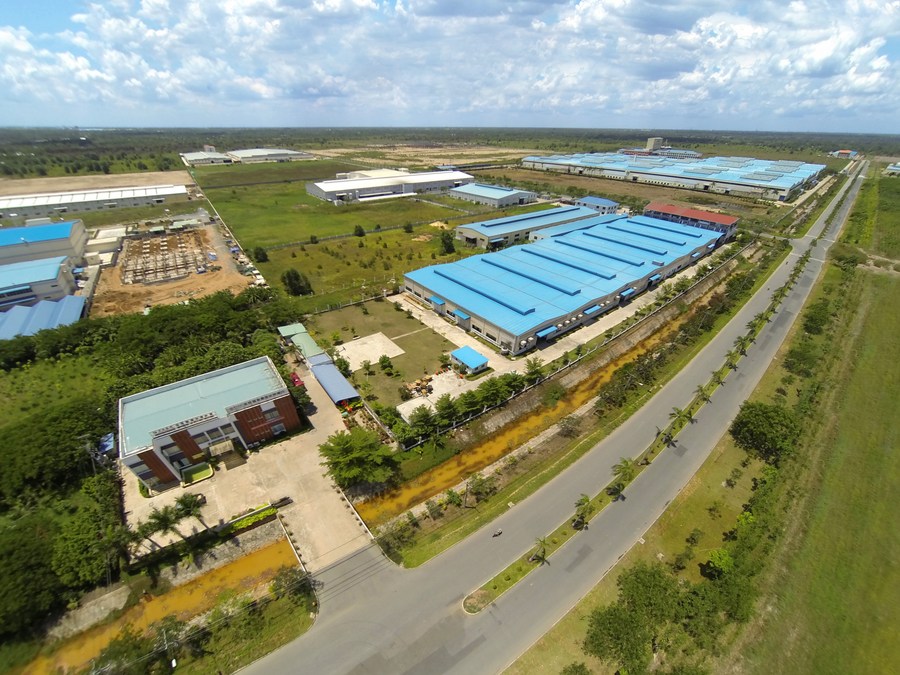

Photo taken on May 21, 2015 shows a view of the Long Jiang Industrial Park in Tien Giang, southern Vietnam. (Xinhua)
The six LMC countries of China, Cambodia, Myanmar, Laos, Thailand and Vietnam have seen the cooperation gain initial achievements in five key priority areas of connectivity, production capacity, cross-border economic cooperation, agriculture and poverty alleviation, and water resources, said a Vietnamese expert.
Closer cooperation among the Lancang-Mekong Cooperation (LMC) countries, which will hold their third leaders' meeting via video link on Monday, can help address regional challenges timely and effectively, and bring long-term benefits to their peoples, a Vietnamese expert said.
The six LMC countries of China, Cambodia, Myanmar, Laos, Thailand and Vietnam have seen the cooperation gain initial achievements in five key priority areas of connectivity, production capacity, cross-border economic cooperation, agriculture and poverty alleviation, and water resources, said Hoang Quoc Dung, a member of the executive board of the Vietnam Association for Conservation of Nature and Environment.
"As an ordinary resident in the Mekong sub-region, I'm impressed by achievements in the priority area of agriculture and poverty reduction," Dung told Xinhua in an interview.
With action plans on agricultural and environmental cooperation implemented, farmers of the six LMC countries benefit from exchanges of varieties of plants and animals, agriculture skills training, and trading of farm produce, especially fresh tropical fruits of Mekong countries and hybrid rice of China, he said.
According to Dung, agricultural trades have also been boosted by enhanced connectivity under the LMC, noting that the New International Land-Sea Trade Corridor, a trade and logistics passage jointly built by western Chinese provincial regions and ASEAN countries, helps facilitate agricultural product trades, such as importing vegetables from northwestern China's Gansu province to Vietnam and Vietnam's tropical fruits to southwestern China's Chongqing municipality.
"Amid COVID-19 outbreaks, which have disrupted global and regional supply chains and international travel, I hope that the LMC countries will take this opportunity to speed up customs clearance for smoother trade flows," he said.
Enhanced connectivity brought by infrastructure construction has also promoted tourism in the LMC countries, Dung said."More and more Chinese visitors are coming to Thailand, Cambodia and Vietnam, and vice versa."
In 2019, Vietnam received more than 5.8 million Chinese visitors, up 16.9 percent, which accounted for 32.2 percent of its total international arrivals of the year, according to the Vietnam National Administration of Tourism.
"Improved tourism ties lead to improved people-to-people exchanges among the LMC countries, which contribute to better mutual understanding and trust as well as all-round cooperation among them," he said.
Dung also paid special attention to water resource cooperation under the LMC as an environmentalist."Achievements and international cooperation on data and information sharing, flood management, hydropower development, and environmental management in the Mekong region are very important," he said.
"Better cooperation on water resources among the LMC countries will help lower vulnerability of people living in the Mekong Basin to floods' impacts," Dung said, adding that Vietnam and China can share hydrological information and statistics in both rainy and dry seasons, establish early warning systems and coordination mechanisms in the management of floods, droughts and other natural disasters.
Regarding the COVID-19 epidemic, Dung said the LMC countries should accelerate coordination and sharing of COVID-19-related data, noting that both Vietnam and China have timely shared information on the outbreak and technical guidelines for prevention, control, diagnosis and treatment.
He suggested the six LMC countries strengthen exchanges of experiences in disease spread prevention, patient treatment and vaccine development, while maintaining trade exchanges.
Initiated by China in 2014, the LMC consists of six countries - China, Cambodia, Myanmar, Laos, Thailand and Vietnam.
The Lancang River originates on the Qinghai-Tibet Plateau in southwestern China. It is called the Mekong River as it flows through the other five countries before emptying into the sea.